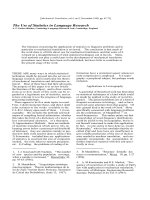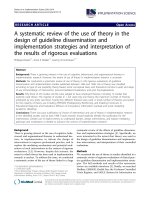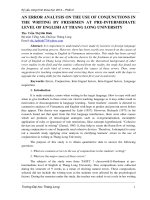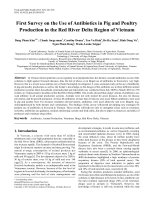ACTION STORIES: THE USE OF NARRATIVE IN COUNSELING AND PSYCHOTHERAPY
Bạn đang xem bản rút gọn của tài liệu. Xem và tải ngay bản đầy đủ của tài liệu tại đây (2.75 MB, 15 trang )
<span class="text_page_counter">Trang 3</span><div class="page_container" data-page="3">
Coppight <small>20 </small>07 of Healing <small>Stories: </small>Tlte <small>Use </small>ofNanatkte in <small>Counseling and </small>
Psychotlter-apyby Stanley Krippner, Ph.D. Copyrights to individual chapters retained by the
iuthors. AII rights to
Healing Stories: Tlte Use of Narratioein
Counseling andPsycltotherøpy are reserved.
No part of this
publication mayb9
reproduced ortrànsmitted in <small>any </small>form, or by <small>any means, </small>whether electronic or mechanical, whether
by photocopying, recording, or by entering into any information storage or retrieval
ryri"*,
eitherin
pârt or as a whole, witfrout the prior written permission of theChapter
2,
'Just Listening: Narrative and Deep lllness,"is
reprinted,with the permission of Famiỵ, <small>Systerns 9 </small>Health. Chapter 12, "Sryle,"-s reprinted ùvith theỵermission <sup>of </sup><sup>Riverhead Books. </sup><sup>Chapter </sup><sup>3, </sup>"Emplotting the Traumatic Self:
Nar-iative Revision and the Construction of Coherence," Chaptet l2,"Vietnam Combat
E4periences and Rites of <small>Passage: </small>Healing Through Telling One's Story,," Chapter
L7, "Psychotherapy The
Art
of Experience," and Chapter 18, "Action Stores," <small>are</small>reprinted with the permission of <small>The </small>Hurnanistic <small>Psychologist.</small>
This edition was published <small>as a </small>paperbound book by Front Cover designed byJon Mayer
Back Cover
desỵed
by Gộrman Aguilera Ampudia of Popete GráficoCover photograph by RonnyMastrion
Section-separating photographs by Bijan Yashar Special thanks to Ca¡los Adrián HemándezTavares Printed in Canada
<small>(</small>
</div><span class="text_page_counter">Trang 4</span><div class="page_container" data-page="4"><small>Éi"e </small>in <small>Counseliog </small>
"od <sup>JP"y.hoÉh"ttnoy</sup>
<small>u: kry: </small>A <small>guide to </small>time-limited $pamie <small>S. </small>Perry E¿M. L. Grave, Eds.). New
<small>ng tlte </small>
ffix
<small>of </small>thefrst <small>(and orten </small>onỵ)<small>athologies, and 4aradoxes. </small>New Yorls
Ă therapist of being impotent.
In
<small>Tåa</small>The Center for FamilY Learning. <small>r¡ </small>witlr Bruce Howe). Pilgrinage: <small>The</small>
<small>'o therapeutic ¿z¿b. </small>New Yorlc W.
W'
CF]I,\PTE,R,
ENGF]ITE EN
Ilene Ava Serlin
Growing attention is being paid to the use of narratives for healing (Feinstein 8c
Krippner,
1988;Ma¡
1989,Sarbin,1986).
However, these narratives are usually verbal, andtÏe
stories they tell comefrom
the oral tradition.The
predominance of verbal narïatives reflects a culturein which
the wordand the eye take precedence over the body and intuitive ways of knowing.
The
postmodem information e4plosion has increasinglyreduced human interactions
to bits
ofinformation,
to cognitive processes that parallel those of the computer.The
imageof
the computer as a symbolfor
this postmodern situation tells usthat
it
is information which is of top value. The information <small>age </small>brings <small>a </small>lossof
the tactile dimension of li-fe, a replacement of behavior by cognition, action is
devalued. Psyche, understood as an
interior
eventof
habitual and somewhatchangeable thought patterns, is no longer
in
our worlds,in
the landscape,in
social action. Psyche is not understood <small>as </small>speaking through action.
Yet narratives may be non-verbal <small>as </small>well <small>as </small>verbal. Actions tell stories; in the
old
days, we weretold
to judge people bytheir
actions,or
that actions spokelouder than words. We were taught that integrity meant <small>a </small>congruence between
individuals'thinking, feeling, and action, or, <small>as </small>the Buddhists <small>say, </small>between
bod¡
speech, and mind. We <small>also </small>knewhoweasilywords could coverdevious intentions
or
behavior, andjudged
others' wordsby their
"goodnessof fit" with
their behavior,how
they "walkedthei¡ talk" Finall¡
v/e may rememberthe
earlystories told to us by our mothers, not so much
in
the words or the storyline,but
in the
toneof
voice,the
cool handlaid on
abrow,
her silent presence.The
psychologicalmeaningwas embeddedin these tactile moments, much <small>as </small>Proust's
memorywas embedded
in
a madeleine cookie.The
meaning of stories liesnot just in thei¡
verbal contentor
storyline,but in
the whole gestaltof
context,atmosphere, and
timing.
Yet most ofus <small>are </small>not trained in the art ofnon-verbal storytelling. As children, we may have learned
to
mime,to mimic
each otheror
our teachers.We
mayhave leamed
the agility of
acrobatics,to
sensethe
communicationin
theteamwork of sports, to know which limbs can be trusted when
dimbing
a tree.Children in
other cultures, however, learn a great deal more about nonverbal</div><span class="text_page_counter">Trang 5</span><div class="page_container" data-page="5">626
<small>JH["rliog Súo.i""s </small>]lL.
(J"" <sub>of Nao"¿úive </sub><sub>i.n </sub><sub>Co*o"eling </sub><sub>and </sub><sub>ìFeychoúLe"a¡,y</sub>behavior. For example,
in
Bali, children are taught specific dance forms at an eafly <small>àge, </small>in which their parents use their own bodies to mi¡ror and to shape thelimbs of their
children.Through
these dances, andin the
dancesof
othercultures, children learn important lessions about cultural synbols, values, and
Beyond the early experiences of play, and the often-dreaded gym class, most
\Mestemers do not learn how to articulate their bodies
with
any of thesophisti-cationwithwhich
theylearn to articulatewords.Yetthe abilityto
be nonverbally articulate and communicative is teachable, and potentially available for everyone.For example, in
mytherapeuticworkwith
cancerpatientqwith seniors in nursinghomes, and
with
psychotherapy clients,I
draw extensively from their behaviorsto
weave nonverbal narrativeswhich
are healing.Through
movement, theye:(press grief and loss, disconnection and blockage, but then the movement may
also
turn
intojo¡
reconnection,
and a renewedlife
flow.The
stories of death andrebirth,
descentinto
sadness and ascentinto jo¡
and disconnection andreconnection, a(pressed
tlrrough
movement, are ancient and commonto
all humankind.How
can we describe these nonverbal narrativeslAs
a dance therapistwho
was trained
in
movement notation,I
have learned to recognize patterns of time,*ght,
space, andflow in
a movement <sub>process. </sub>Like
a good storyr a good or healing movement patternwif
have a dear beginning, middle, and enã.Like
good music, healing
movementwill
have an inner logic, <small>a </small>fl.ow of eventswhich
changes organically
without
being contrived. Good or healthy movement hasthe characteristics described bythe Hungarian psychoanalyst Susan
Deri
(19SS)<small>as a </small>gogd Gestalt, in which the parts
fit
togetherin
a coherent and meaningfirlwhole. This good Gestalt also describes agoodlife <small>as </small>
setforthbyMaryCatheãne
Bateson (1989) who uses the metaphor of jazz improvisation to show that the
composition of <small>a </small>good life has harmony <small>as </small>well <small>as </small>some dissonance, balance <small>as</small>
well <small>as </small>some asymmetry and <small>a </small>beginning, middle, and end.
Continuing the metaphor of jaz,zimprovisation, <small>\¡¡e </small>can <small>see </small>that the
compo-sitional aspects
of
any art form, whetherit
be painting, music or dance, can be used to diagnose and also to help construct"nd <sup>t..otrõtroct </sup>
<sup>a </sup><sup>healthy </sup><sup>life. </sup>How
would this process be described verballyì
Although
movement speaks eloquendy about a person's story,or
about agroup process,
litde
of this communication shows upin
the literature. Besidesthe usual
pathologicall¡oriented
phrasesof
the intake interview ("patientap-plared dishevelled, twitched
nervousl¡"
and so on), notes usually arè not-aãe
ofthe
nonverbal <sub>behaviors. </sub>In
mybreast cancer research group, for o<ample, onewoman began the group
with
shoulders rotated in, <small>a </small>sunken torso, armsäose toher side, standing back away from the circle, and using <small>a </small>very
limited
amountof
personal space,(that is, her kinesphere). By the end ofthe group, <small>she </small>was standing straighter, had an e4panded range
of motion
and interactive gesture, andwaiinitiating
movements. Group process observationsmight
pick up the factthat
</div><span class="text_page_counter">Trang 6</span><div class="page_container" data-page="6">. ir
Co*r""liog <small>end lPsycLoúhe"a¡,y</small>ght specific dance forms at an dies to mirror and to shape the r, and
in the
dancesof
othert
cultural symbols, values, and often-dreaded gyrn class, most,odies
with
any of the sophisti-let the ability to be nonverballytentially available for everyone. ratients,
with
seniors in ntrrsing rtensively from thei¡ behaviorsrg.
Through
movement, they<small>e, </small>but then the movement may
life
flow.The
stories of death tojo¡
and disconnection ande ancient and common
to
all<small>ves? </small>
As
a dance therapist whoI to recognize pattems
oftime,
,
Like
a goodstory
a good or inning, middle, and end.Like
:r logic, <small>a </small>
flow
of eventswhich
ychoanalyst Susan
Deri
(1988)'in
<sub>a </sub><sub>coherent and </sub><sub>meaningfirl</sub><small>) as set </small>forth by Mary Catherine mprovisation
to
show that the<small>rs </small>some dissonance, balance <small>as</small>
e, and end.
<small>)n, </small>we can <small>see </small>that the
compo-inting,
music or dance, can beeconstruct <small>a </small>healthy life.
How
<small>Lt </small>a person's story,or
about <small>ai's </small>upin
the literature. Besidesintake interview ("patient
ap-rn), notes usually are not made
search group, for example, one
t, <small>a </small>sunken torso, arms close to
using
averylimited
amountof
lofthe
group, shewas standingd
interactive gesture, and was nsmight
pick up the fact thatshe had worked through some of her
initial
anger andwithholding,
had begunto
experience more trust, and was emerging as oneof
the group leaders.The
research results
might
showthat her
anxiety and depressionhad
decreased;neither report would note the story told
in
her action.lvVhy is there is such a lack of attention to the nonverbal storyl
The
historyof literacy in the West <small>has </small>emphasized the written text,
with
its dialogue betweenwriter and reader. The text,
with
its prototypein
the Torah, Bible, and Koran,emphasizes the written word. Movement behavior, or action, is not understood as
a text which is a
dialogue betweena
moverand
a witness.How might
movement be understood <small>as a </small>text in <small>a </small>way which might provide the foundation
to understand the language and stories of the
bodyl
In this
chapter, therefore,I work with the
ideaof text to
understand and inteqpretthe
languageof
movement. Oncethis
foundationis
provided,it
ishoped that the language of movement maybecome more accessible and usefirl
to the therapist who does not utilize dance and/or movement <small>as </small>modalities.
Action Language
As a movement therapist,
I
read body movement <small>as </small>the text throughwhich
the patient's mode
of
being is made manifest.If his (or
her) movements aremeaningftrl, then how can he (or <sub>she) </sub><sub>and </sub>
I
understandtheir meaningl
Can welet
themovement speak
its
or¡¡n meaningr so thatinappropriate metaphorical or
symbolicstructures are not imposed on
itì
The popularization of body language has
spawned a
bewildering
ør'ayof
nonverballanguages. For example, we
might
imagine<small>a </small>group of dinicians inteqpreting the
mean-ing
of
the movement momentin
Figure 1.figure
1
<sub>One </sub><sub>therapist </sub><sub>might point </sub>
<sub>out the </sub><sub>subject's</sub>"closed'versus "open" position; another might notice the timing, weight shifts,
and phrasing; <small>a </small>third might <small>see a </small>boy developmentally fixed at his mothefs knee"
these perspectives
is
real,or
are theyall
containedin the
movementl \Mhatcriteria would guide <small>a </small>therapist's choice of focus, and what level <small>at </small>what moment
is salient for the therapeutic processl
The process
bywhich
movement becomes <small>a </small>text which has <small>a </small>narrative form,literal and
symboliccontent, and
meaningis
onewhich I call
kinestheticimagining.
Kinesthetic refersto the kind of
perceptionwhich
originatesin
moving muscles.
It
is compounded from the Greekword "kinesis" which means</div><span class="text_page_counter">Trang 7</span><div class="page_container" data-page="7">628 ìHlr.liog Súoti"",
TL.
<small>{.J"" of </small>Nr."¿óive in Co-oseling .od F"y"Loúh.".n <small>y</small>"perception." In the original rootword, therefore, the combination ofmovement
and perceptign <sub>rya! </sub>alreadv present. Imagining is rhe process by which images are generated and formed. This understanding
ofimagining
<small>as Írrì </small>active processis
based on Jean-Paul sartre's(196s) definition of
image asa
"structureof
imaginative consciousness" and on Edward casey's (1976) descrỵtion
ofi-"S-nation <small>as a </small>verb and <small>a </small>process rather than <small>as a </small>product or a tfring-.
put togethä,
kinesthetic imagrning-is
the
processby which the perceptioir
"titi"[ <sup>ao*</sup>
moving muscles generate and make o<plicit imaginativè structures of
As
a narrative <sub>process, </sub>kinesthetici-"st"irg
givesform
and articulation toevents in time. Instead
ofbeginningwith
theword, kinesthetic imaginingbeginswith the
concrete sensationof moving
muscles.Moving *rrrá"t
generate associated_feelings, thoughts, and meanings which show up ai embodiedlmages. These embodied imagesflow into
one another, creating ã storyline or a dañce.These dances speak about individual personality style
and
oryanizat,on, about<small>S_o_up </small>dynamigs, and about
mythic
patterns: they are ootrrr"tb"l personal and collective mythologies (Feinstein& Krippner,
1988).As
embodied narrative,kinestÏetic
imagining_is a dynamic processby which
peopleoften
compose themselves andform
their lives.If
cartesian dualism has split cognirion frombod¡
then kinestJreticimagin-ing
must brin_g co_gnition and the body back together.The unity of
cogniãonand body is what Merleau-Ponty (7962) <sub>called </sub>
incamate
perception" in-whichthe
self knowsitself through
actions experiencedïvitrñ a
cãrtain horizon. Percsptiqr is thus understood <small>as </small>a set of relationswithin
the sel{, and betweenself and world. Perceptions viewed <small>as </small>pattems of relatedness are called "kinetic
melodies."
This
descriptionof
image as patterned process contrastswith
the traditional descriptionof
an image as a purely visual picturein
the mind.An
image is
not
athing or
an object,but
a "visibleof
thè second power,a
carnalessence or icon of the
frst"
(Merleau-PonLy, 1962,p. I6Q. An
image isnot
<small>a</small>thing, but
an active wayor
seeing, a paradoxical seìof
relations be-tween the visible and the invisible which is rooted in the perceptions of <small>a </small>lived body.When
reconnected
to
its groundin
perception and body, an image is the embodiedunity
ofvision
and body.- ]f4. loving
<sup>group </sup><sup>tells </sup><sup>a </sup><sup>srory </sup><sup>like </sup>
<sup>an orchestra plays </sup>amelod¡
then theindividual
mover must be warmedup
before heor
she-can make-movementmelodies, just as an instnrment must be warmed up before
it
can play auditorymelodies.
A
bodywarm-r'p is not a
mechanicalpto."rr,
asis äetãbi.
bodyconditioning-, but-it is intendedto bring conscious perception to the body.
Any
one ofa number ofexercises. might accomplish this, but all-would bring <small>a\ry'areness</small>
to the
breath,to
isolated body parts, andto the
orchestration of-body parts</div><span class="text_page_counter">Trang 8</span><div class="page_container" data-page="8">"" <sup>io Co.o""liog rod </sup><sup>JP"yohoúL""on </sup><sup>y</sup>
<small>:, </small>the combination ofmovement
is the process by which images
<small>rf </small>imagining <small>as </small>an active process
'y <small>s </small>(797 6) description of
imagi-roduct or <small>a </small>thing. Put together,
r the
perceptions arisingfrom
;inative <sup>strucỷrres </sup><sup>of </sup>
<small>conscious-ỗ </small>gives
form
and articulation to d, kinesthetic imagining beginsles.
Moving
muscles generate :h show up <small>as </small>embodied images.creating a storyline or a dance.
y style andorganrzanon, about
rey are nonverbal personal and 1988).
As
embodied narrative,i*agi"-gether.
The unity of
cognition'incarnate perception" in
which
<small>Lced </small>within a
certain horizon.<small>ns </small>
within
the self, and between frelatedness are called "kineticned process contrasts
with
theuisual picture
in
themind. An
<small>, </small>of the second power, a camal
t62,
p.164). An
image is not aal set
of
relations between the:ceptions of <small>a </small>lived body. \Mhen
>dy,
ar
image is the embodiedrestra plays a
melod¡
then the<small>.e </small>
or
she can make movementI up before
it
can play auditory:al process, as
is
aerobic body<small>us </small>perception to the body.
Any
<small>.s, </small>but all would bring awareness
re orchestration
of
body partsworking together. Some people
find it
helpfirl to beginwith
closed eyes, rotum
away
from
rnûagesof
the outerworld
andto
focus on inner or proprioceptivesensations.
Tuming
inward can turn perceptioninto
insight.Afterwarm-up
exercisesin
one class, a studentìilrotein
her joumal:I
had no <small>eyes, </small>only <small>senses. </small>Theywere black <small>eyes </small>sometimes. Thankfi¡lto be <small>a </small>big moving <small>mass; </small>the burden of consciousness, too much relating to the world thro"gh the <small>eyes.</small>
A
second studenf noted:I
wasn't there.All
the parts of my body were involvedinto
twisting,contracting, stretching to explore the outside world. My body was <small>a </small>huge
We which could <small>see </small>everywhere
-
<sup>my body was skin </sup><sup>which </sup><sup>could </sup><sup>sense</sup>all over, my body was all ear which could hear every sound.
My
tongue was mywhole body andI
tasted the whole world. No intellecrual feelingexisted. I was not
happ¡
unhapp¡ I just was.Improvising with
basic sensationsof weight,
athird
student movedinto
images of a deep underworld and the formlessness out
ofwhich
all forms arise:That may <small>be </small>why I <small>chose </small>to explore the Dark Goddess, who demanded
the entire creative "eye" lurking in that vast, all encompassing darkness.
I felt there <small>was </small>vision, but of <small>a </small>different order. The <small>eye </small>seemed to <small>be </small>part
of
the tissueof
the stomach; the navel, at the center, was embeddedwithin.
It
was recognizable only <small>as </small>impulse. <small>. . . a </small>pulsing.It
<small>is a </small>very deepwisdom
...
untranslatable...
the dark source ofall-there-is...
the darkmaterial, formless, <small>shapeless, </small>from which everything is made.
The descriptions above are all poetic, movement imagery like verbal imagery
is a poesis, a "making."
Most
of our words usedto
describe movementelỗeri-ences, however, are
still
dualistic, such as the static, objectified, nounform of
the word "image." The task of
finding
an active embodied language hasprece-dents
in
the psychoanal¡ic tradition. Roy Shafer (1976) claims:I
have good reason, therefore,to
say that my project ofdevising an action langrrage to <small>serve as a </small>new language for <small>psyc-hoanalysis </small> fallswithin the
great and arduoustradition of
systematic anddinicall¡oriented
psychoanalpic thinking. (p. x)
How
can action be a languageor
atextl
Language, accordingto
linguistic philosopherPaul
Ricoeur (7976), canbe
characterizedin
th¡ee ways. First,</div><span class="text_page_counter">Trang 9</span><div class="page_container" data-page="9">66t
<small>IHI""liog Súo"ies: </small>lfL"
{J"r <small>of </small>Na*'"úi'"
io <small>Counseling ondl ìFsychoúLe.'¡,y</small>signs
of
semiotics,but is
instead patternsof word or
gesturewith
semantic referents and which are visiblein
the openingpictues.
From these pictures,it
can be seen that movement language is expressed <small>as </small>kinds of qualities, relations,
and actions,
that indudes
sense andform.
Second, movement as language discourse occursin
interaction between mover and v¡itness, and opens <small>a </small>sharedworld,
an "ensembleof
references openedup by
everykind of
text."A
textmediates between writer and reader, speaker and listener, or mover and witness.
Action
language, which bridges inner sensation and outerform, into
dialogue between mover and witness, is therefore a text.In
traditional psychology, thespoken
word
is usually the text, action language adds anotherform of
textin
which images and meaning occw.
Just as
a
poem hasmetaphor
and/or symbol,or
levelsof
meaning, so <small>a</small>movement text has levels of meaning. And just <small>as </small>we have been taught in school
how
to
analyze <small>a </small>poem, orjust
<small>as </small>dinicians are taught howto
analyze levelsof
meaning
in
a dream, so v¡etoo
can analyzn levelsof
meaningin
a movement text.A
text, accordingto
Ricoeur (1976),is
characterized bymultiple
levelsof
meaning, each
ofwhich
corresponds to a kind of imagery. The fi¡st level is the teleological level. This level is characterized by movement which has <small>a </small><small>progres-sive </small>forward direction, opening into consciousness and intentionality.
Teleotogi-cal movement is shown
in
Gestalt exercises, inwhich
the person's intention is dear in the movement. There is <small>a </small>one-to-one correspondence betweenintention
and action,
in
movements such <small>as </small>(I
am) retreating, and(I
am) advancing.The
use
of
simile andirony
often occursin
this level. For q(ample, <sub>as </sub><sub>one student</sub> movedwith
another, she discoveredthat
the way they leanedinto
each otherwas like her relationship
with
her boyfriend.All
ofher issues about commitment, trust, and mutuality were evidentin
the movement, the movement v¡as not her relationshipwith
herbofiend,
but it was <small>a </small>simile for her relationshipwith
herThe
second levelis the
archeological level.Here, forward
movement is contrasted by movements which stumble and fäll, which forget and which pause. These are "depth" movements which move backwa¡d into time, and which speakof
regression, death, desire, and unconsciousness.This kind of
movement is shown in the following descrỵtion ofthe mythological figure of Ereshkigal "Sheis the root
of
all, where enerry isinert
and consciousness coiled asleep. She is the place where potential life lies motionless-
<sup>but in </sup><sup>the pangs of </sup><sup>birth" </sup><sup>(Perera,</sup>1981, p. 32). Suzanne Langer (1953) calls the unity of force and meaning on rhe
archeological level a symbol.
This
particular symbolis not
a picturebut is
<small>a</small>"pattern
of
sentience"which
is madeup of
feelings and emotions, shaped <small>as</small>complexes of tension, and formed <small>as </small>rhythm into streams ofresolutions.
Acdon,
expressed
in
thiswa¡
does not "mean" or referto
something else,it
is alreadysymbolic. Jung (1953) also observed that <small>a </small>symbol is not mereỵ <small>a </small>picture, but is
</div><span class="text_page_counter">Trang 10</span><div class="page_container" data-page="10"><small>"e </small>in <small>Counseliog and ÌFsyohoúÀe"apy</small>
yord
or
gesturewith
semantic,ictures. From these pictures,
it
I <small>as </small>kinds ofqualities, relations,
:cond, movement as language nd witness, and opens a shared
by every
kind of
text."A
textlistener, or mover and witness. and outer form,
into
dialogueIn
traditional psychology, thee adds another
form oftext in
rl, or
levelsof
meaning, so <small>a</small><small>; </small>we have been taught in school taught how
to
analyz* levelsof
:ls
of
meaningin
a movement acterizrdby multiple
levelsof
f imagery. The first level is the
tovementwhich has <small>a </small>
<small>progres-s </small>and intentionality. Teleologi-vhich the person's intention is :espondence between
intention
ng, and
(I
am) advancing.The
[. For example, as one student ry they leaned
into
each other[her issues about commitment,
:nt, the movement <small>tryas </small>not her
le for her relationship
with
herHere, forward
movement iswhich forget and which pause.
'ardinto <sub>time, </sub><sub>andwhich </sub><sub>speak</sub>
<small>ss. </small>
This kind of
movement is gical <small>fi </small>gure of Ereshkigal <small>" </small>She ciousness coiled asleep. She is t in the pangsofbirtÍr"
(Perera,tyofforce
and meaning on thenbol is not
a picturebut is
<small>a</small>ings and emotions, shaped <small>as</small>
streams of resolutions.
Action,
o something else,
it
is alreadyl is not merely <small>a </small>picture, but is
õ61-an act, õ61-an attinrde; what distinguishes a symbol is the observing consciousness
of the observer.
correspondence between
implicit
and e4plicit forms are elỗressed <small>as </small>ritual
andsacred story, not necessarily
in
the one-to-one cofrespondence between actionand meaning exemplified by metaphoric movement. For example, in the opening pictures, the joined hands and symmetrical bodiesmake thepatterns explicit, <small>as</small>
ão the formal content of circles, spirals, and mandalas which appear spontane-ously
in
groupsof
moving people.Further,
sacred movement is markedby
<small>a</small>particular quality of energy.
It
<small>is </small>visible andpalpable <small>as </small>mrminosity, <small>as </small>"authenticilovementt' in which the
transcendentfunction
bridgesmoving
and being moved. Sacred movement requires <small>a </small>surrender ofpower, of ego, and towa¡dfaith
to be moved, therefore,
it
can be the most transformative kind of movement.Action
language focuses, clarifies, differentiates, and describes the emerging kinesthetic't
pfocess <small>as </small>they learned to transcribe felt-images into words or drawing to move
ih" i*"g.r
further.The
stagesof
developmentindude
authentic movement, ampli-ûcation, description, differentiation, and naming.Ar
ott" student moved, thefollowing
archetypal figure emerged:The strongest, most singular image I encountered during this <small>class </small>was
<small>a </small>dance
I
call my Goddess dance which tumbled out of my body the way<small>a </small>shell rolls out
ofthe
<small>sea. </small>You selected special music [and] all my jointssoftened. Without
tfing
<small>a step </small>I could feel the weight ofmybody makinga hundred
little
adjustments' atiny
current of energ¡r flowing throughevery
pathwa¡
downto
the earth, upto
the crown' back andforth
<small>...</small>Grecian <small>vases </small>showing women in tunics and sandals, their hair bound
in
fluttering chignons, <small>a </small>Botticelli painting of <small>a </small>soft-boned lady covered
with
tiny flowers and some
g W
1ov'rỵ; the Star card from the Tarot deckwhich shows <small>a </small>nude woman with <small>a </small>long round shape, her face hidden
in
a shadow. These images floated before me as
I
swayedto
the music.Slowl¡ I
started towalk
I was aware of the fleshiness of the bottom of my feet, how far
I
could"step into" them. Sometimes
I
was dancingwith
<small>a </small>veil, sometimeswith
<small>a </small>rope of flowers.I
was with other women' one of several dancing. Thedanie took <small>a </small>se¡pentine shape, turning back and forth on <small>a </small>line with the feet barely leaving the ground, but the knees fluid.
At
certain pointsI
knelt, but the motion was continuous.My
arms would furl andunÍrrl,
twine or curl, close
to
my body or reachingfor
a bud, or the handof
another to dance
with
me.After
<small>a </small>while my face allowed the feelingof
grace
I
felt to form a small smile...
all the regression this quarter was <small>a</small>molting to let this butterfly emerge.









